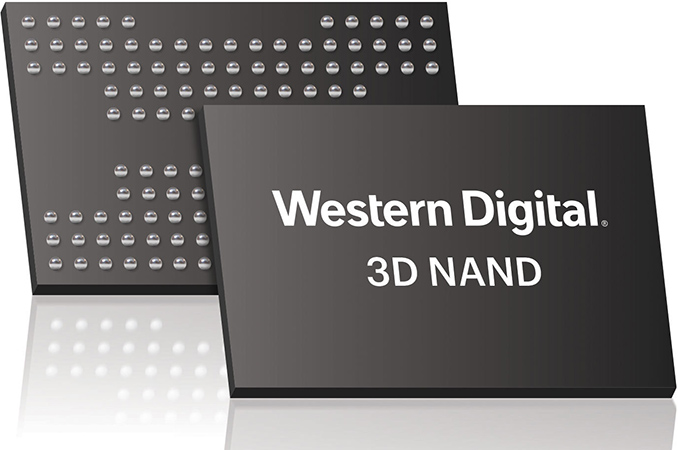Western Digital Begins Shipments of 96-Layer 3D QLC-Based SSDs, Retail Products
by Anton Shilov on November 1, 2019 2:00 PM EST
Western Digital announced this week that it has started shipments of its first products based on 3D QLC NAND memory. The initial devices to use the highly-dense flash memory are retail products (e.g., memory cards, USB flash drives, etc.) as well as external SSDs. Eventually, high-density 3D QLC NAND devices will be used to build high-capacity SSDs that will compete against nearline hard drives.
During Western Digital's quarterly earnings conference call earlier this week, Mike Cardano, president and COO of the company, said that in the third quarter of calendar 2019 (Q1 FY2020) the manufacturer “began shipping 96-layer 3D QLC-based retail products and external SSDs.” The executive did not elaborate which product lines now use 3D QLC NAND, though typically we see higher capacity NAND first introduced in products such as high-capacity memory cards and external drives.
Western Digital and its partner Toshiba Memory (now called Kioxia) were among the first companies to develop 64-layer 768 Gb 3D QLC NAND back in mid-2017 and even started sampling of these devices back then, but WD/Toshiba opted not to mass produce the NAND. Meanwhile, in mid-2018, Western Digital introduced its 96-layer 1.33 Tb 3D QLC NAND devices that could either enable to build storage products with considerably higher capacities, or cut costs of drives when compared to 3D TLC-based solutions.
At present, Western Digital’s 1.33 Tb 3D QLC NAND devices are the industry’s highest-capacity commercial NAND chips, so from this standpoint the company is ahead of its rivals. But while it makes a great sense to use 1.33 Tb 3D QLC NAND for advanced consumer storage devices, these memory chips were developed primarily for ultra-high-capacity SSDs that could rival nearline HDDs for certain applications.
It is hard to say when Western Digital commercializes such drives as the company is only starting to qualify 96-layer 3D QLC NAND for SSDs, but it will definitely be interesting to see which capacity points will be hit with the said memory.
On a related note, Western Digital also said that in Q3 2019 (Q1 FY2020), bit production of 96-layer 3D NAND exceeded bit production of 64-layer 3D NAND.
Related Reading:
- Western Digital Begins to Sample QLC BiCS4: 1.33 Tbit 96-Layer 3D NAND
- Western Digital Starts Shipments of Client SSDs Based on 96-Layer BICS4 3D NAND
- Western Digital Announces Four Bit Per Cell 64-Layer 3D NAND Flash
- Toshiba's 768Gb 3D QLC NAND Flash Memory: Matching TLC at 1000 P/E Cycles?
- Intel Announces SSD 665p: Denser, Faster QLC NAND
- Micron: Shipments of 3D QLC for SSDs Nearly Double QoQ as Wafer Starts Cut Again
Source: Western Digital










24 Comments
View All Comments
azfacea - Friday, November 1, 2019 - link
getting closer and closer to deprecating hard drives. I say hard drives are done for by 2025 even for cold storage. its not just SSDs getting cheaper at a much better rate than HDD. its also that hard drives become more expensive as they lose volume. annual HDD shipments are below 50% of their peak and dropping fast. that means fixed costs have to be amortized over a constantly shrinking volume.SSDs getting cheaper, HDD getting more expensive there is only one conclusion.
Scipio Africanus - Friday, November 1, 2019 - link
Problem there is HDD is still much better for cold storage. HDD can last some years but SSDs can start having bit rot after a few months.azfacea - Friday, November 1, 2019 - link
in addition to being flat out wrong, u fail to explain why a controller cant deal with that "once in a few months" ??even more nonsensical than the arguments i heard for why optical drives are here to stay
faydrus - Friday, November 1, 2019 - link
SSD's are not suitable for archive storage, especially if they're taken offline. While there's some flash products (especially NOR flash) that are spec'd to hold data for 10+ years, there's no retention time specs for the dense, multi-voltage-level NAND flash that SSD's use.I suspect if we did get that info, it would not be very good.
Billy Tallis - Friday, November 1, 2019 - link
The spec for consumer SSDs is retention for a full year when the write endurance has been exhausted. Fresh NAND rather than worn-out NAND has significantly better retention. It's still not a good choice for offline archival storage, but for more typical incremental backup duty cost is much more of a barrier than retention.Dark_wizzie - Friday, November 1, 2019 - link
What is duty cost?rpg1966 - Saturday, November 2, 2019 - link
Slight edit to make it more understandable:"but for more typical incremental backup duty, the cost is much more of a barrier than retention."
deil - Monday, November 4, 2019 - link
your investment per backup. On pricy storage, that need a lot of maintenance is way higher.ksec - Saturday, November 2, 2019 - link
>in addition to being flat out wrong,LOL.
HDD may be dying in consumer space, but it is doing extremely well in Enterprise and Datacenter. The Cost of amortised over shipment completely neglect the cost / GB shipped to these customers. MAMR or now renamed as EMAR still has life to bring 10x capacity improvement. While NAND has reached its die shrinking advantage and will now require die stacking to improve its Cost model. Something which is not quite proven yet, as the higher die stacking hurts yield.
There are also other aspect which NAND currently does not fit the backup, archive, and high capacity volume storage requirement. So to say it is gone in 5 years time is premature.
That is assuming HDD maker execute on their roadmap.
8lec - Saturday, November 2, 2019 - link
Optical drives are great... Cuz 2 of our cars cannot play anything except CDs. Lmao